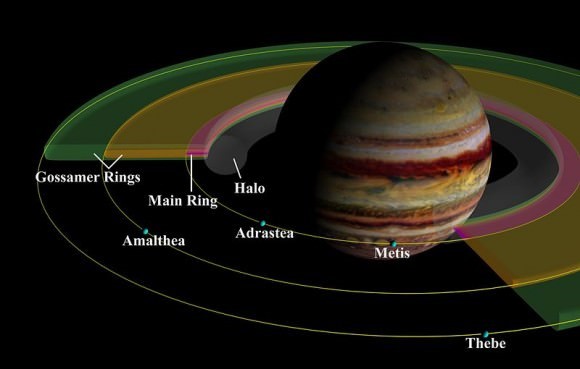Planet Jupiter Facts and Information
The biggest planet in our solar system, Jupiter also has a large presence in pop culture, including many movies, TV shows, video games, and comics. Jupiter was a notable destination in the Wachowski siblings’ science fiction spectacle "Jupiter Ascending," while various Jovian moons provide settings for "Cloud Atlas," "Futurama," "Power Rangers," and "Halo," among many others. In the movie "Men in Black" when Agent J – played by Will Smith – mentions he thought one of his childhood teachers was from Venus, Agent K – played by Tommy Lee Jones – replies that she is actually from one of Jupiter’s moons.

Figure 1. Planet Jupiter Facts and Information
Figure 1 shows Jupiter is covered in swirling cloud stripes. It has big storms like the Great Red Spot, which has been going for hundreds of years.Jupiter is a gas giant and doesn't have a solid surface, but it may have a solid inner core about the size of Earth. Jupiter also has rings, but they're too faint to see very well.[1]
Facts about Jupiter
Jupiter is the fourth brightest object in the solar system.
Only the Sun, Moon and Venus are brighter. It is one of five planets visible to the naked eye from Earth.
The ancient Babylonians were the first to record their sightings of Jupiter.
This was around the 7th or 8th century BC. Jupiter is named after the king of the Roman gods. To the Greeks, it represented Zeus, the god of thunder. The Mesopotamians saw Jupiter as the god Marduk and patron of the city of Babylon. Germanic tribes saw this planet as Donar, or Thor.
Jupiter has the shortest day of all the planets.
It turns on its axis once every 9 hours and 55 minutes. The rapid rotation flattens the planet slightly, giving it an oblate shape.
Jupiter orbits the Sun once every 11.8 Earth years.
From our point of view on Earth, it appears to move slowly in the sky, taking months to move from one constellation to another.
Jupiter has unique cloud features.
The upper atmosphere of Jupiter is divided into cloud belts and zones. They are made primarily of ammonia crystals, sulfur, and mixtures of the two compounds.
The Great Red Spot is a huge storm on Jupiter.
It has raged for at least 350 years. It is so large that three Earths could fit inside it.
Jupiter’s interior is made of rock, metal, and hydrogen compounds.
Below Jupiter’s massive atmosphere (which is made primarily of hydrogen), there are layers of compressed hydrogen gas, liquid metallic hydrogen, and a core of ice, rock, and metals.
Jupiter’s moon Ganymede is the largest moon in the solar system.
Jupiter’s moons are sometimes called the Jovian satellites, the largest of these are Ganymeade, Callisto Io and Europa. Ganymeade measures 5,268 km across, making it larger than the planet Mercury.
Jupiter has a thin ring system.
Its rings are composed mainly of dust particles ejected from some of Jupiter’s smaller worlds during impacts from incoming comets and asteroids. The ring system begins some 92,000 kilometres above Jupiter’s cloud tops and stretches out to more than 225,000 km from the planet. They are between 2,000 to 12,500 kilometres thick.
Eight spacecraft have visited Jupiter.
Pioneer 10 and 11, Voyager 1 and 2, Galileo, Cassini, Ulysses, and New Horizons missions. The Juno mission is its way to Jupiter and will arrive in July 2016. Other future missions may focus on the Jovian moons Europa, Ganymede, and Callisto, and their subsurface oceans.
Jupiter Notes
- Jupiter is the largest planet of the Solar System. It is the fifth planet from the Sun.
- Jupiter is a gas giant, and it lacks a true surface. It is made up of about 90% hydrogen and 10% helium.
- Jupiter has a faint ring system, and it is second in terms of the number of satellites only to Saturn. It has 79 moons, four of them, the Galilean moons, helped shape our view of the Universe.
- Jupiter’s moon Europa has many chances of developing life.
- Jupiter shrinks 2 centimeters every year because it radiates too much heat.
References:
- https://solarsystem.nasa.gov/planets/jupiter/overview
- https://space-facts.com/jupiter/
- https://nineplanets.org/kids/jupiter/
Cite this article:
Gokula Nandhini K (2023), Planet Jupiter Facts and Information, AnaTechmaz, pp.461

